by Raine, Outreach and Education Coordinator
Did you know that Pacific lamprey are native to the Salinas River and other streams in San Luis Obispo County? If your answer is no, you’re not alone—neither do most people who live here. A lifelong resident of San Luis Obispo County, I had no idea about our local lamprey until 2021, when I joined the California Conservation Corps Watershed Stewards Program (WSP) and encountered them up close during my field work. I immediately fell in love with these fascinating fish and took every opportunity to participate in lamprey-related projects and learn more about them.
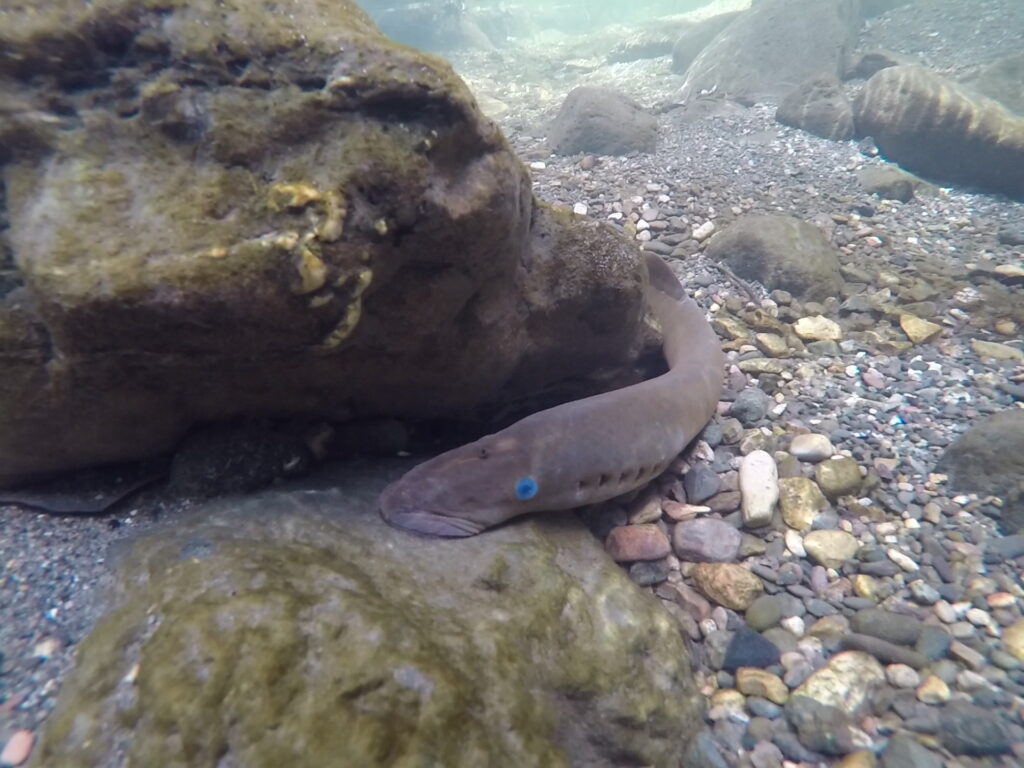
What Are Lamprey?
Pacific lamprey (Entosphenus tridentatus) are one of the oldest types of fish on earth. Lamprey existed before the dinosaurs and even before trees!1 They are found up and down the Pacific coast of North America, including San Luis Obispo County. Although Pacific lamprey have survived five mass extinctions, their geographic range and overall numbers have decreased dramatically in recent decades due to human-made barriers, habitat degradation, and climate change.
Much like salmonids (the family of fish that includes salmon and steelhead trout), Pacific lamprey are anadromous, meaning that they are born and reared in freshwater, they migrate to live in the ocean as adults, and then they return to freshwater at the end of their lives to reproduce.
Pacific lamprey live in streams for 3-7 years as filter-feeding larvae (ammocoetes), at which point they transform into juveniles (macrophthalmia) and migrate to the Pacific Ocean. They spend about 1-3 years in the ocean as parasitic adults before returning to freshwater to spawn (reproduce). Pacific lamprey die after spawning, and their decomposing bodies contribute valuable marine nutrients to the freshwater ecosystem.2
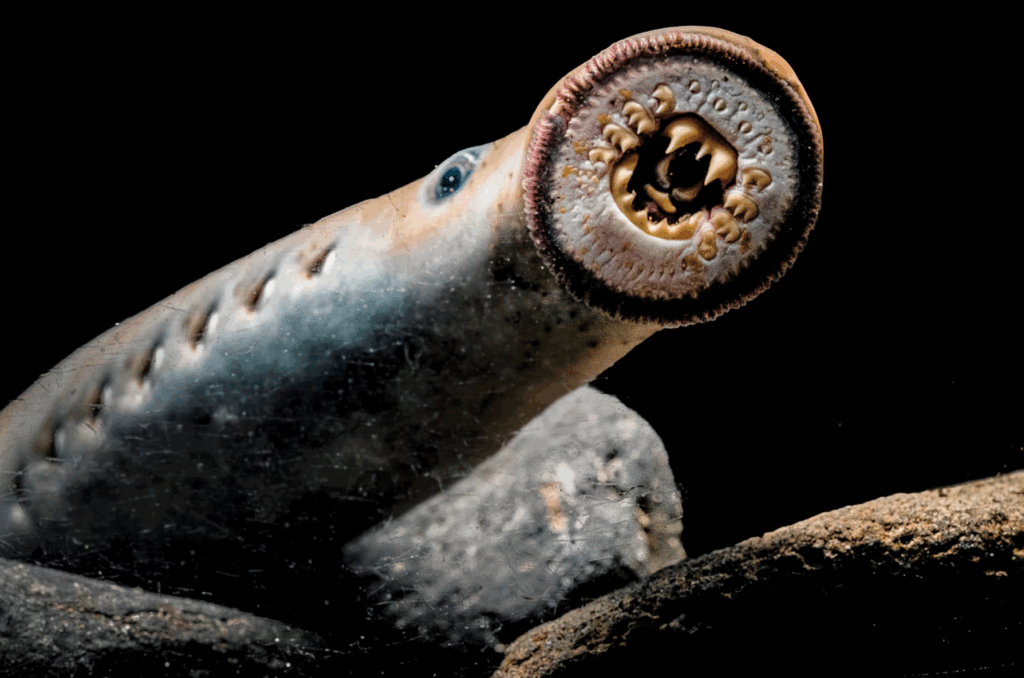
Lamprey Keep the Water Clean
Although lamprey are better known for their parasitism of other fish, they only live as parasites during their adult stage. As larvae (ammocoetes), Pacific lamprey live in fine sediments on the river or creekbed. Lamprey ammocoetes eat small bits of decomposing matter that have fallen to the bottom of the river, which means that they prefer slow-flowing water environments such as pools, side channels, and… you guessed it… beaver ponds! Filter feeders like lamprey have an important role in maintaining water quality. A study by Cal Poly San Luis Obispo grad student Parker Kalen in partnership with the City of SLO found that Pacific lamprey ammocoetes may reduce the amount of harmful bacteria in the water. 3
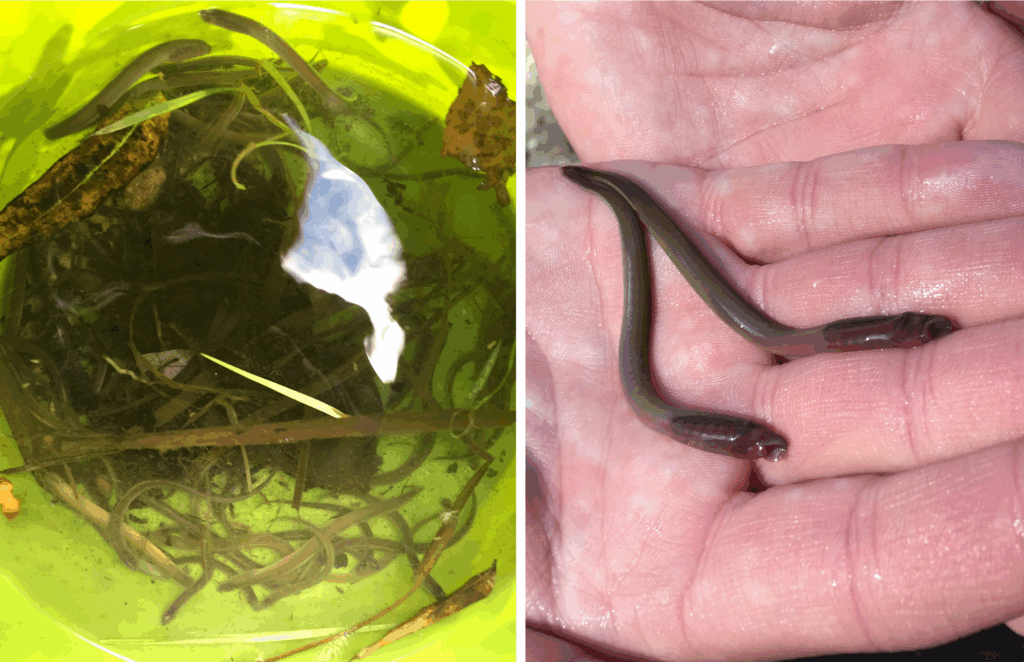
Lamprey Conservation Efforts
Pacific lamprey, also called “eels” in many Indigenous communities, are an important traditional food source for Tribes and First Nations in the Pacific Northwest. Lamprey are a high-fat, nutrient-dense food that is available outside of salmon season, making them critical to many Tribes’ survival, and Tribes have been at the forefront of lamprey conservation efforts. However, because lamprey fisheries do not have commercial value—and probably also because people are weirded out by how lamprey look—lamprey were not broadly prioritized for study and conservation until more recently.
Many fish passage projects historically focused only on fish passage for salmonids, while ignoring the fish passage needs of Pacific lamprey. Whereas adult salmon can jump up to 6.5 feet to cross obstacles,4 lamprey make their way through challenging areas by attaching their mouths to rocks and making many small jumps. The ability of lamprey to suction onto rocks actually allows them to climb up waterfalls that salmonids cannot traverse. However, lamprey need to attach to surfaces without sharp angles, and fish passage devices designed only for salmonids are typically built at a 90° angle. This has often resulted in fish passage ‘solutions’ that block lamprey from making their way upstream. This happened in our very own San Luis Obispo Creek, where fish passage modifications made to the Marre Weir to benefit steelhead ended up completely excluding lamprey from the creek. Luckily in this case, lamprey were relatively easy and inexpensive to accommodate—in 2017, just four years after the Central California Lamprey Working Group installed a low-tech “Lamp Ramp” to the weir, lamprey were again seen gracing SLO Creek with their magnificent presence.5
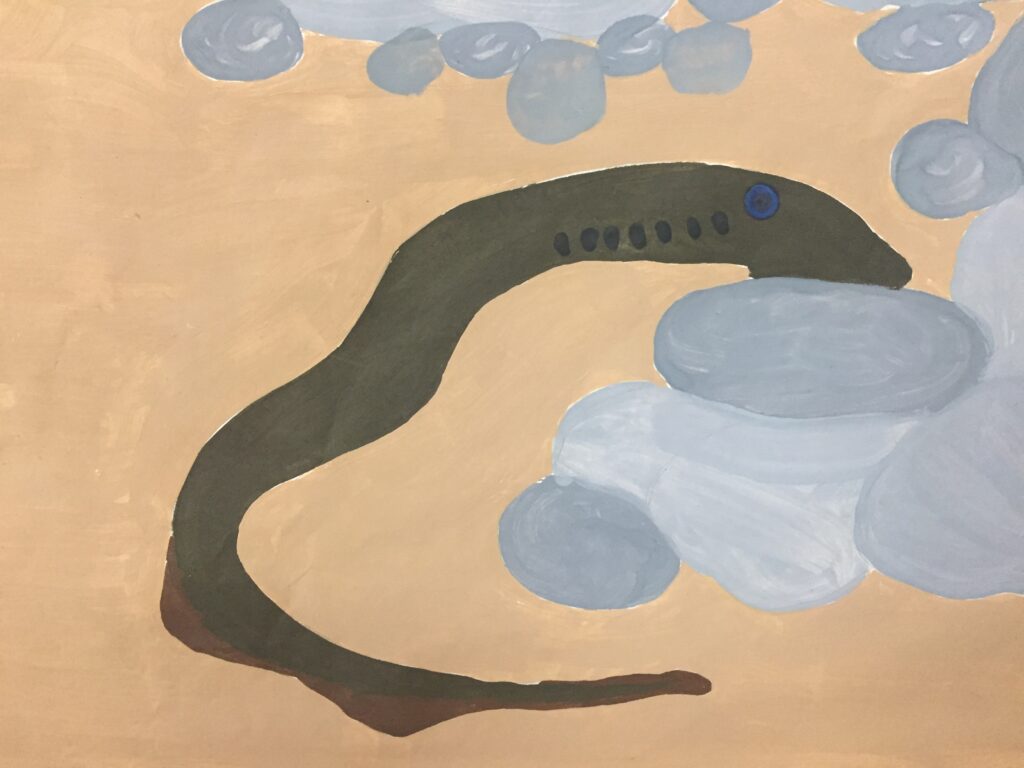
Thankfully, more and more people now recognize the importance of lamprey and have joined Tribes’ efforts toward lamprey conservation. Pacific lamprey conservation and monitoring involve techniques such as electrofishing and eDNA. Electrofishing is a common technique in freshwater fisheries science that involves introducing a small electrical current into the water to temporarily stun fish in order to collect them for measurement, rescue, or other purposes. Electrofishing is labor intensive and must be done with care, but it allows for in-depth study and monitoring of fish populations.
A more recently developed technique, environmental DNA (eDNA), involves testing a water sample to see if it contains genetic material from a particular animal species. By testing for eDNA up and down a stream, scientists can identify how far upstream a given species is found—of particular importance for lamprey and other anadromous fishes, which now face many human-made barriers to accessing their upstream habitat. eDNA is a promising tool which is less invasive than electrofishing in testing for fish presence or absence in a stream.
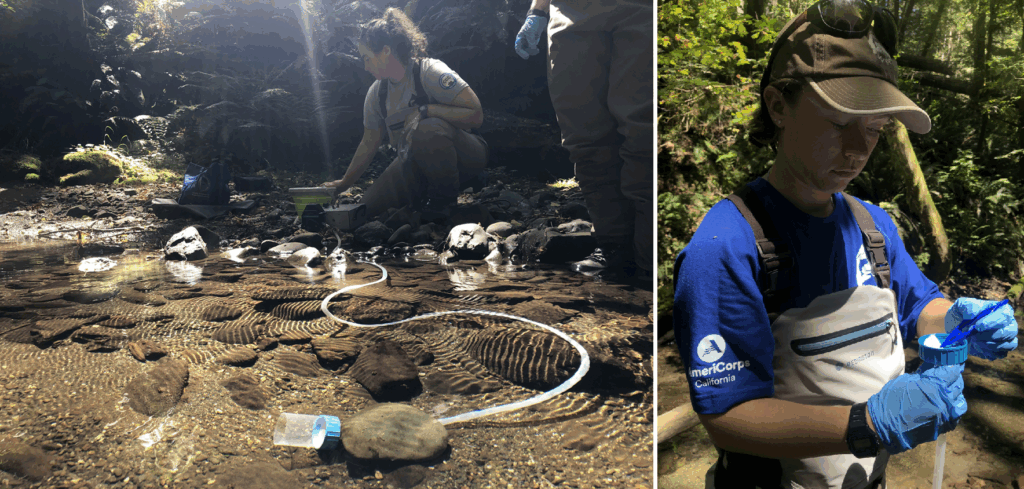
Challenges to Lamprey on the Salinas River
Drought and lack of water are some of the major threats to Pacific lamprey survival. In the Salinas River, fisheries biologist Stewart Reid has observed that juvenile Pacific lamprey ready to migrate to the ocean may attempt to swim downstream when it rains, but then the Salinas dries up again in its agriculture-heavy lower reaches, and the fish cannot make it out of the river into Monterey Bay.6
Pacific lamprey strandings and habitat disconnection have been ongoing issues in our region. The Regional Implementation Plan for lamprey conservation in our region describes periodic mass mortalities of juvenile Pacific lamprey, who try to make their way downstream toward the ocean only to end up stranded in drying reaches of the Salinas River.7
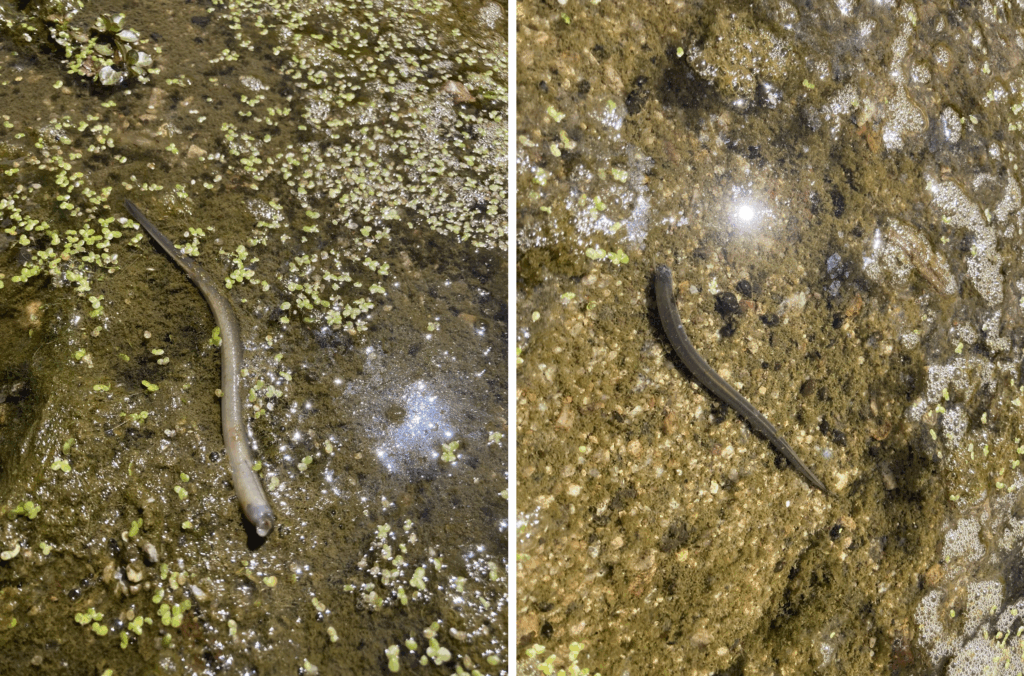
In August 2025, we found one dead juvenile Pacific lamprey in the Upper Salinas River. The lamprey was found in shallow water, and its cause of death was unknown. CDFW biologists were notified and retrieved the specimen for further study. While it was sad to see the lamprey wasn’t alive, it was thrilling to realize that some lamprey are likely still managing to survive the conditions of our Upper Salinas River.
A Reminder of Our Interconnectedness
Both beaver and Pacific lamprey teach us how taking care of the river can be embedded into our everyday actions: Beavers build dams, which serve as habitat for lamprey. Lamprey help with water quality as larvae, and their carcasses as adults provide nutrients that support insects, which in turn provide food for a variety of fish species. The challenges that lamprey face in the Salinas River are an important reminder of how interconnected and interdependent our lives are with those of other species. Whether human, beaver, or fish, we all need water to survive—so join us in continuing to work alongside beavers and lamprey to keep clean water in the river.
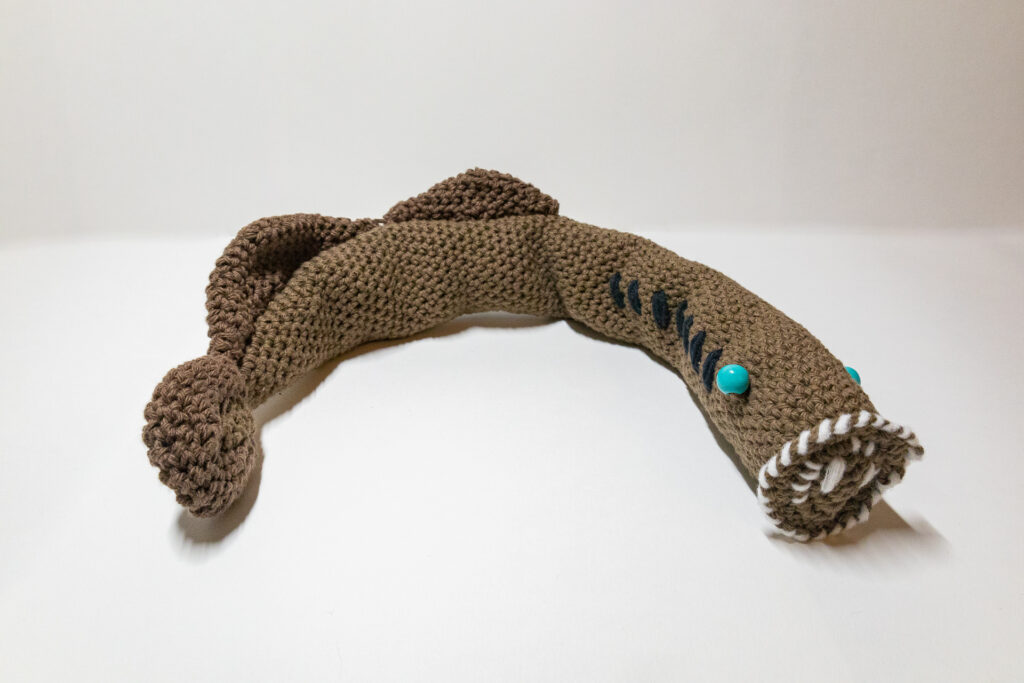
Further Reading
Local
- SLO Beaver Brigade’s electrofishing adventure this summer on the Carmel River:
https://www.instagram.com/slobeaverbrigade/p/DKz-Xeyy1UF
- Learn more about Pacific lamprey and their history here in San Luis Obispo County in this 2023 blog post from the Morro Bay National Estuary Program. Features a cool video of lamprey spawning in San Luis Obispo Creek!
https://www.mbnep.org/2023/10/20/wildlife-spotlight-pacific-lamprey-on-the-central-coast/
- The story of how lamprey were returned to San Luis Obispo Creek using a “Lamp Ramp”:
https://fishhabitat.org/waters-to-watch/detail/san-luis-obispo-creek-california
For Kids
- Awesome resource about Pacific lamprey for kids (contains activities):
https://www.fws.gov/sites/default/files/documents/2024-04/2112.pdf
General
- Video on Pacific lamprey conservation:
https://www.pacificlamprey.org/2025/02/11/new-video-taking-care-of-pacific-lamprey/ - A short piece about Pacific lamprey by Keith Parker, fisheries biologist with the Yurok Tribe:
https://nativefishsociety.org/news-media/pacific-lamprey - Pacific Lamprey Conservation Initiative:
https://www.pacificlamprey.org/aboutplci
References
- Source: https://wdfw.wa.gov/species-habitats/species/entosphenus-tridentatus ↩︎
- Source: https://wildlife.ca.gov/Conservation/Fishes/Pacific-Lamprey ↩︎
- Parker Kalen’s 2022 masters theses on Pacific lamprey: https://digitalcommons.calpoly.edu/cgi/viewcontent.cgi?article=4043&context=theses ↩︎
- Source: https://psf.ca/learn/salmon-facts/ ↩︎
- Learn more about the Lamp Ramp project at: https://www.cafishpassageforum.org/san-luis-obispo-creek-barrier-remediation/ ↩︎
- Source: https://baynature.org/2022/04/20/meet-an-ancient-amazing-fish-in-need-of-an-image-makeover/ ↩︎
- Page 19 of the Regional Implementation Plan has a photo of a 2012 mass mortality event where juvenile lamprey got stranded in a drying reach of the Salinas River: https://www.pacificlamprey.org/wp-content/uploads/2022/10/2022_CASouth-Central-Coast_RIP.pdf ↩︎